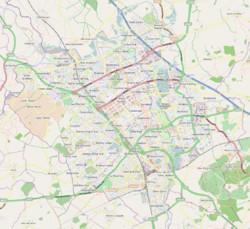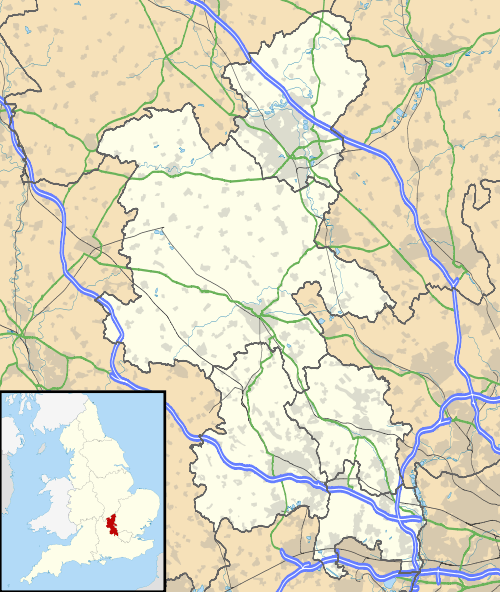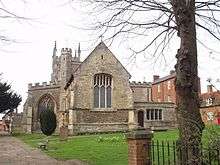Newport Pagnell
| Newport Pagnell | |
|---|---|
 High Street | |
 Newport Pagnell Mapping © OpenStreetMap  Newport Pagnell Newport Pagnell shown within Buckinghamshire | |
| Population | 15,118 (2011 Census)[1] |
| OS grid reference | SP873437 |
| Civil parish |
|
| Unitary authority | |
| Ceremonial county | |
| Region | |
| Country | England |
| Sovereign state | United Kingdom |
| Post town | NEWPORT PAGNELL |
| Postcode district | MK16 |
| Dialling code | 01908 |
| Police | Thames Valley |
| Fire | Buckinghamshire |
| Ambulance | South Central |
| EU Parliament | South East England |
| UK Parliament | |
Newport Pagnell is a town in Buckinghamshire, England.[2] In the Borough of Milton Keynes, it is separated from Milton Keynes itself by the M1 motorway, on which is Newport Pagnell services. The Office for National Statistics records Newport Pagnell as part of the Milton Keynes urban area.
History
The town was first mentioned in the Domesday Book of 1086 as Neuport, Old English for "New Market Town", but by that time the old Anglo-Saxon town was dominated by the Norman invaders. The suffix "Pagnell" came later when the manor passed into the hands of the Pagnell (Paynel) family. It was the principal town of the Three Hundreds of Newport, a district that had almost the same boundary as the modern Borough.
At one time, Newport Pagnell was one of the largest towns in the County of Buckinghamshire (the assizes of the County were occasionally held there) though today, despite its own substantial expansion, it has been completely dwarfed by the growth of Milton Keynes. There were also at one time two hospitals in Newport Pagnell and six fairs were held for the townsfolk throughout the year.
Newport Pagnell became the headquarters of Newport Pagnell Rural District under the Local Government Act 1894. In 1897, Newport Pagnell became the sole civil parish comprising the newly created Newport Pagnell Urban District.
For a hundred years (1867 to 1967), Newport Pagnell was served by Newport Pagnell railway station, the terminus on the Wolverton to Newport Pagnell branch line.
Modern times
Tickford Bridge, over the River Ouzel (or Lovat), was built in 1810 and is the only iron bridge in Britain that still carries main road traffic and is the oldest iron bridge in the world that is still in constant use. There is a plaque near the footbridge at the side that gives details of its history and construction placed there by Newport Pagnell Historical Society.
Between 1817 and 1864, the town was linked to the Grand Junction Canal at Great Linford via the Newport Pagnell Canal.[3]
From 1954, until recently, Tickford Street in the town was the home to the prestigious sports car manufacturer Aston Martin. The Newport Pagnell factory was considered outdated and a new production facility was built near Gaydon, in Warwickshire. There is still a service facility in Newport Pagnell, but the factory on the north side of Tickford St has since been demolished apart from the engine shop, board room and offices that are listed buildings. The land behind these has been purchased by Tesco and the supermarket giant had planned to build an outlet on the site, preserving the original remaining buildings for use by the townspeople. In 2012 the service facility was completely modernised and now also houses a bespoke sales department.
The town is also home to the only remaining vellum manufacturer in the United Kingdom, William Cowley, located at Parchment Works, 97 Caldecote Street.
The modern civil parish of Newport Pagnell stops at the M1, but the ecclesiastical parish extends to include Broughton and Caldecote. The parish church is dedicated to St Peter and St Paul. The alternative rock band, The Smiths mentions the town's name in their song "Is it Really So Strange" from the album Louder Than Bombs.

Population and growth
Although Newport Pagnell is outside the (1967) designated area of Milton Keynes, its growth has been at a similar level to that of the constituent towns of the latter; the two now join at the M1 and there is little distinction between them. The Office for National Statistics regards Newport Pagnell as part of the Milton Keynes Urban Area.[4] Its population in 1971 was 6,000:[5] by 2001 it had reached 15,020. The Borough Council projects[6] that the population will remain broadly stable at this level. However, in its comments on the expansion plans for Milton Keynes, Buckinghamshire County Council challenges this assumption, calling for any further expansion to be to the east of the M1 rather than south across the border into Aylesbury Vale.
Sport and leisure
Newport Pagnell has a Non-League football team Newport Pagnell Town F.C., nicknamed the Swans, who play at The Pavilion on Willen Road. An ITF Taekwon-Do club Kicks Taekwon-Do Academy, who train out of Cedars Primary School, Bury Street, and a swimming pool.
Notable people
- Nigel Benson, the author, was born in Newport Pagnell.
- Steve Brooker, footballer, was born in Newport Pagnell.
- William Bull (1738–1814) (born Irthlingborough) was minister to the Independent Church, now United Reformed Church.
- Oliver Cromwell (son of his more famous father) is rumoured to have died in Newport Pagnell in the spring of 1644.[7]
- Letitia Dean went to Cedars School in the town.
- Kelly George, actor and star of BBC children's television series Grange Hill, lived and was educated in the town.
- Richard Hopkins, the television producer, was born in Newport Pagnell.
- Lawrence Humphrey, (or Laurence Humfrey) DD (1527? – 1 February 1590) English theologian, President of Magdalen College, Oxford, and Dean successively of Gloucester and Winchester.
- Richard Meredith, author, lives in Newport Pagnell.
- Gordon Moakes, bassist of Indie band Bloc Party, was educated in Newport Pagnell, as were the members of the ska punk band Capdown.
- James Nash, World Touring Car Championship driver, lives in Newport Pagnell.
- David Oldfield who played for Leicester City, Stoke City and Oxford United, lived in Newport Pagnell.
- Samuel Pepys stayed at The Swan Revived Hotel.
- Charles Sanford Terry, the historian, musicologist and authority on J. S. Bach, was born in Newport Pagnell in 1864.
- George Walters, born 15 September 1829 in Newport Pagnell, won the Victoria Cross at the Battle of Inkermann (where he was a Sergeant with the 49th Regiment of Foot) on 5 November 1854, by saving the life of Brigadier-General Adams.
References
- ↑ Neighbourhood Statistics 2011 Census Archived 23 June 2013 at the Wayback Machine., Accessed 4 February 2013
- ↑ Parishes in Milton Keynes Archived 8 June 2009 at the Wayback Machine. – Milton Keynes Council.
- ↑ Hadfield, Charles (1970). The Canals of the East Midlands (including part of London) (Second ed.). David & Charles (Publishers) Limited. pp. 272–273. ISBN 071534871X.
- ↑ KS01 Usual resident population: Census 2001, Key Statistics for urban areas
- ↑ Census for Newport Pagnell UD
- ↑ Borough of Milton Keynes population bulletin 2005/6, page 21
- ↑ Newport Pagnell Historical Society Archived 14 December 2008 at the Wayback Machine.
External links
| Wikimedia Commons has media related to Newport Pagnell. |
- The unofficial Newport Pagnell Town website with historical pictures, pictures of the town carnival and a message board for locals and ex pats to keep in touch.
- Newport Pagnell Town Council
